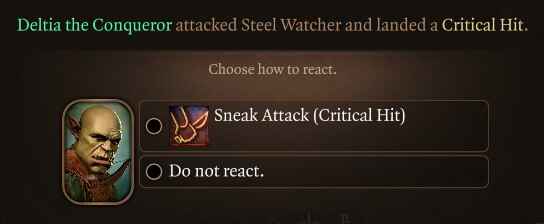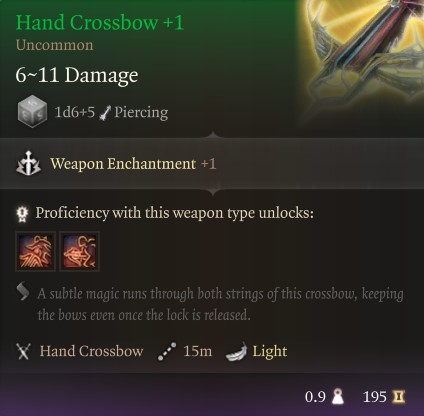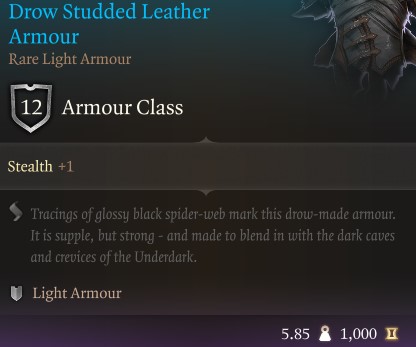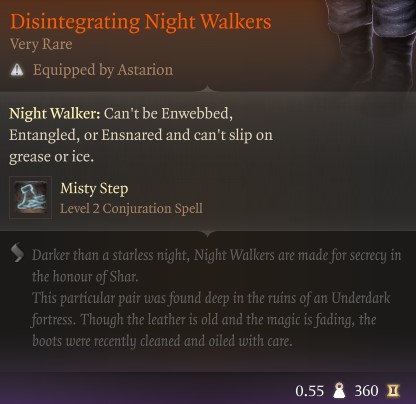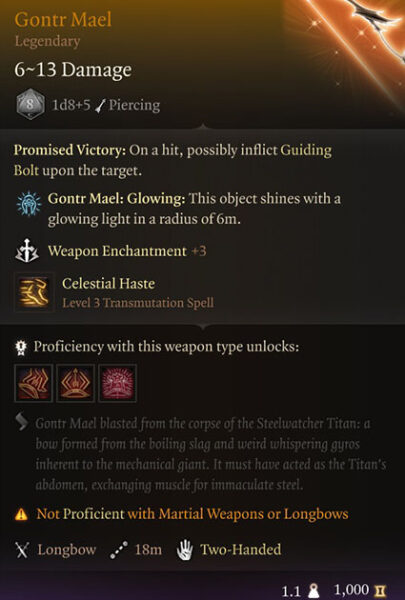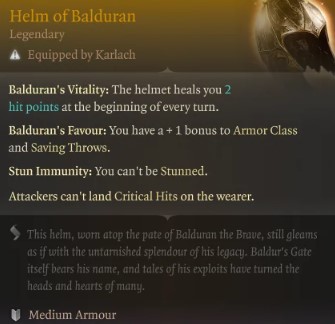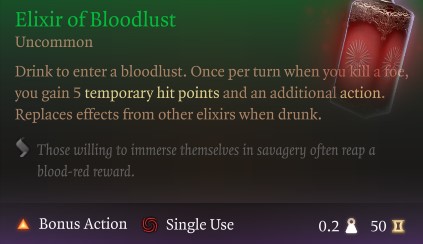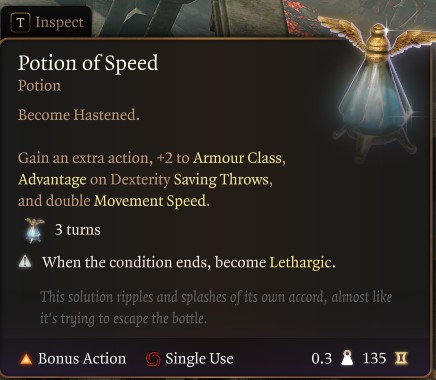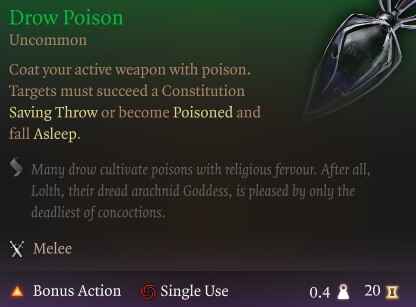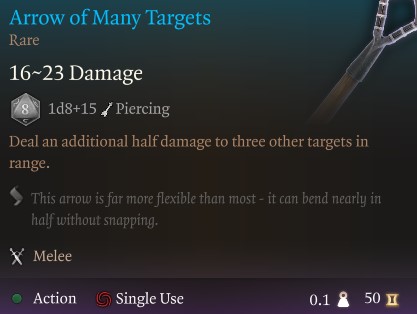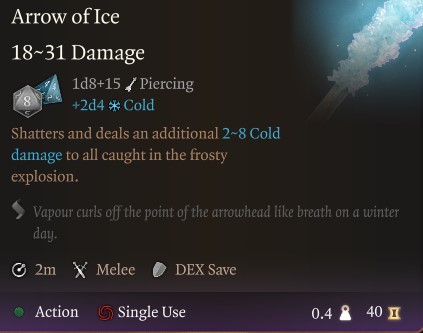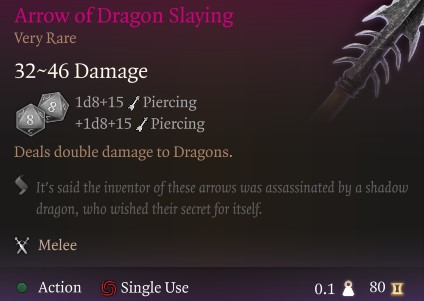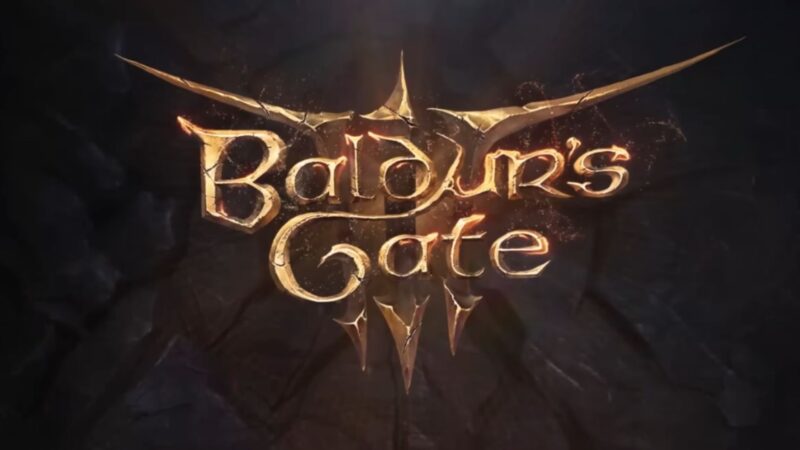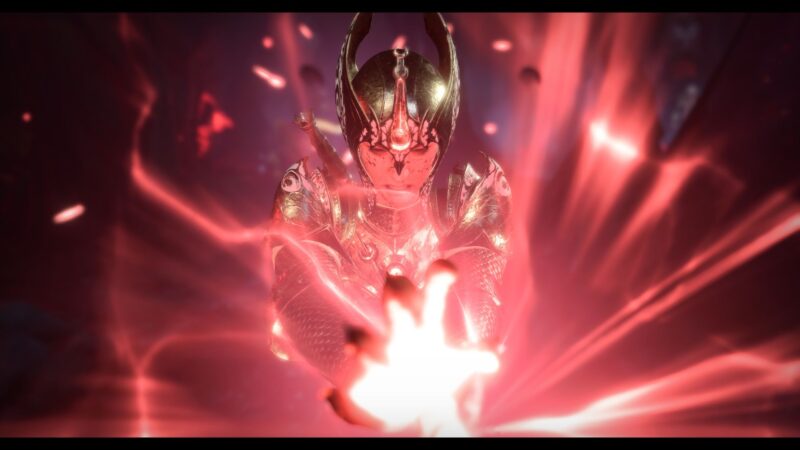This solo guide focuses on the key aspects of a Rogue build in Baldur’s Gate 3 (BG3), intended to play solo without companions.
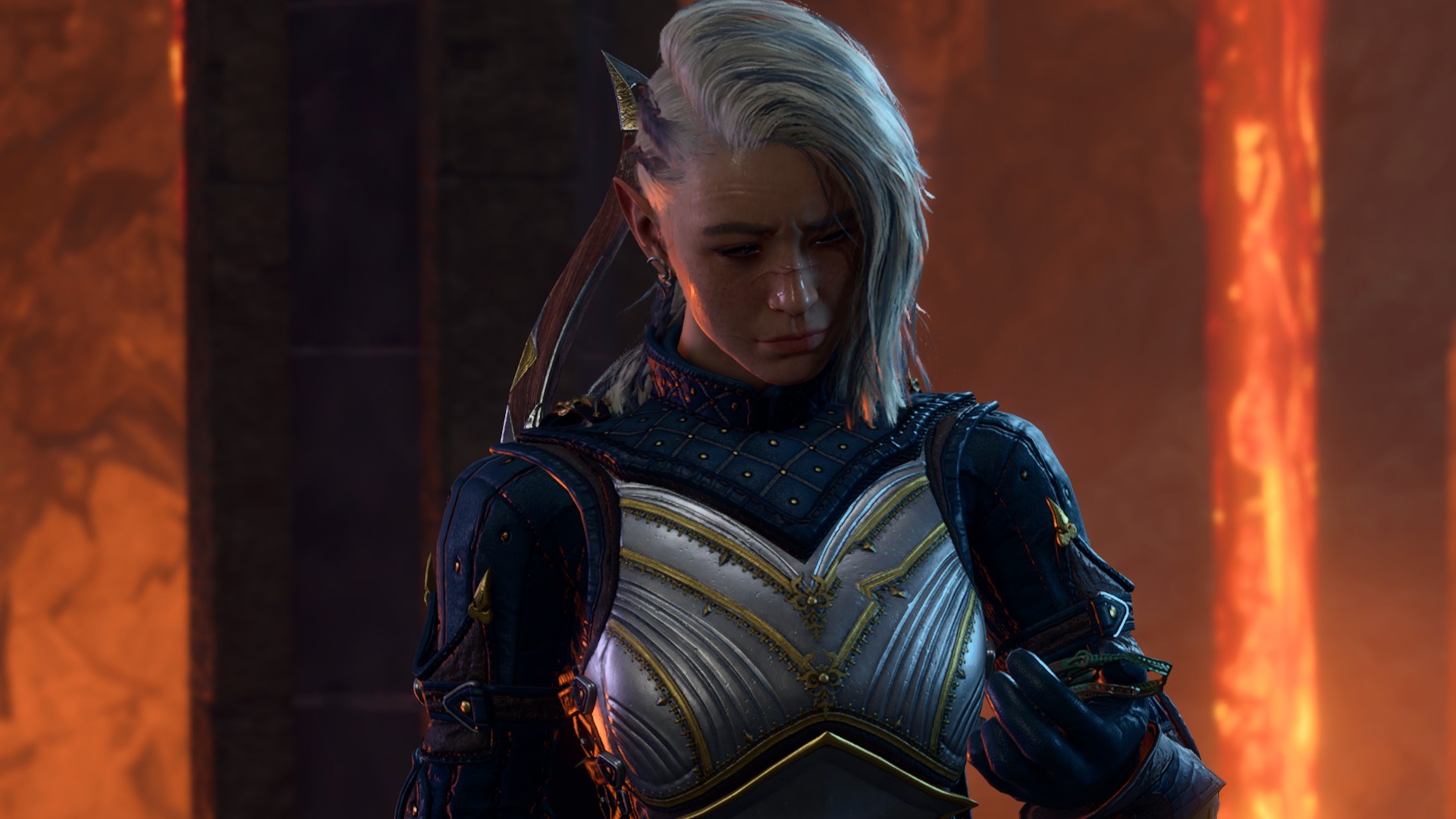
This build page has been updated for the Patch 8 version of Baldur’s Gate 3.
Best Solo Rogue Build Guide
The Rogue in Baldur’s Gate 3 is a master of shadows, skill, and surprise attacks, excelling in both combat and non-combat situations. Rogues are your archetype stealth characters that can play as a range damage dealer or melee. Rogues excel in non-combat situations as well providing lockpicking, stealing, and stealth movement. However, this build will be entirely focused on solo play without companions.
As such, we’ve designed this solo designed for high performance in combat especially if you wish to play on Honour Mode difficulty. This build will utilize multiclassing to gain the most power possible. You can expect a ranged damage-dealing Rogue which emphasises invisibility and stealth for survivability. Let us continue, explaining how to use the Best Baldur’s Gate 3 Solo Rogue Build!
Patch 8 Changes to the Solo Rogue Build for BG3
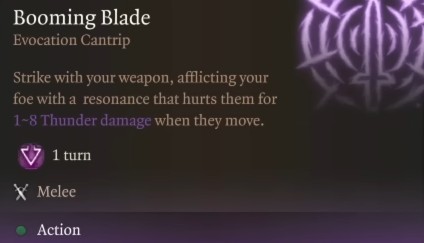
The most significant update to the Solo Rogue build in Patch 8 of Baldur’s Gate 3 is the introduction of the Swashbuckling subclass and the Booming Blade cantrip. These additions give the assassin playstyle additional options, where you can choose the more nimble Swashbuckling subclass for more effective mobility in stealth. On the other hand, you could instead use the Arcane Trickster or multiclass in to an Eldritch Knight Fighter to get access to Booming Blade.
However, going with the Booming Blade route will change some of the traditional rogue playstyle, which tends to be more stealth-based. Even with a melee-focused build, you can still be very effective at initiating combat with stealth strikes. But once enemies are engaged, you’ll need to take more of a frontline melee role. This playstyle may not be to everyone’s taste, but it is a possible option we’ll include in an alternative build below.
Solo Rogue Build Features
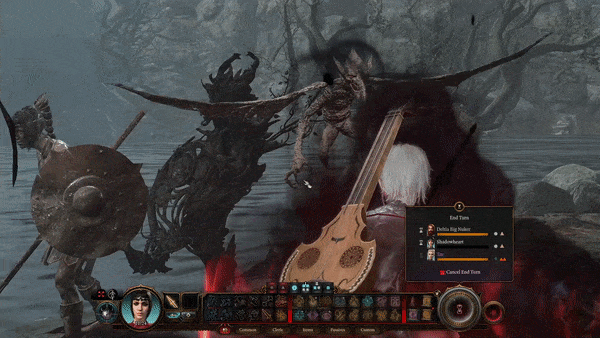
The following list presents all the essential solo Rogue Build Mechanics and Features in Baldur’s Gate 3:
- Primary Ability: Dexterity
- Saving Throws: Dexterity and Intelligence
- Armour Proficiency: Light Armour
- Weapon Proficiency: Simple Weapons, Hand Crossbows, Longswords, Rapiers, Shortswords
- Thief Subclass: grants Bonus Action and resistance to falling damage.
- Advantage: gain an additional dice roll d20 if you strike while hidden.
- Sneak Attack: Deal additional damage while having an advantage.
- Fast Hands: You gain an extra Bonus action.
- Action Surge: Immediately gain an extra Action to use this turn. Recharges on a Short Rest.
- Archery: Gain a +2 bonus to Ranged Weapon Attacks.
- Battle Master Subclass: Gains Maneurvor weapon skills.
- Extra Attack: Can make an additional free attack after making an unarmed or weapon attack.
- Defence: Gain a +1 bonus to Armour Class while wearing Armour.
- Gloom Stalker Subclass: subclass focused on damage and mobility.
- Spell Casting: Ranger multiclass unlocks limited spellcasting and spell slots.
- Umbral Shroud: Wrap yourself in shadows to become Invisible if you are obscured.
- Dread Ambusher: gain a +3 bonus to initiative, increase movement speed on the first turn, and extra damage.
Related:
How to Play the Rogue Solo in Baldur’s Gate 3
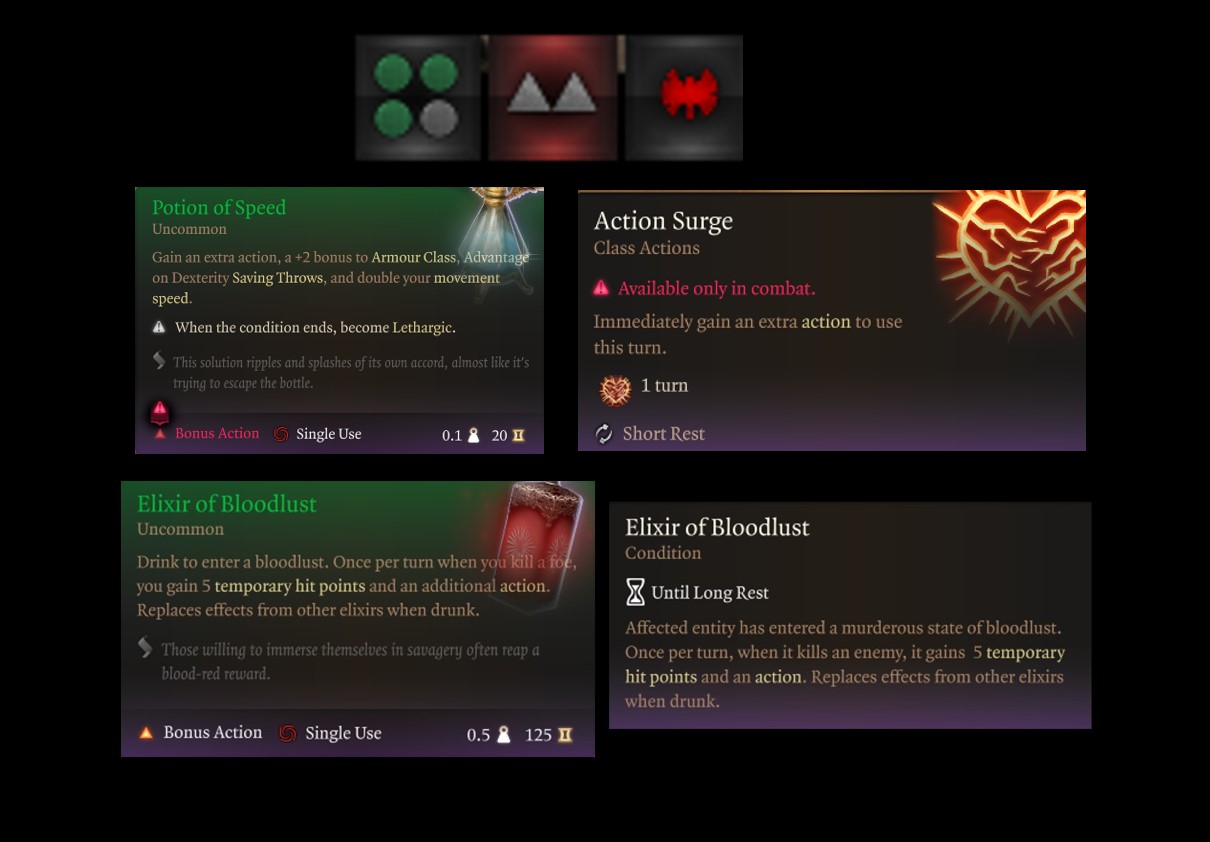
Baldur’s Gate 3 can be played solo by either opting to disregard companions or recruiting them and later dismissing them to your camp. Although playing a Rogue build solo presents a challenging experience, it is possible to complete the entire game solo on Tactician or Honour Mode difficulty.
Below are some general tips on how to play the best Rogue build in BG3 Solo:
- Stealth: You should try to start every combat encounter from stealth and trigger the Surprise status effect.
- Invisibility: When you are afraid of detection, use invisibility rather than stealth, this can help you sneak into areas or attack with surprise.
- Ranged: It is much easier to play range in the first part of the game, aiming to keep 12-15 meters distance from enemies.
- Loot Everything: You will need a lot of gold to buy consumables, potions, and ammunition so loot and sell constantly.
- Crafting: Elixirs and potions are vital, and you need to purchase materials when trading for crafting.
- Reach Level 5: Spend the early part of the game completing every quest to reach level 5 where your power dramatically increases.
- Sell Often: Your carrying capacity will be limited so sell often, and store excessive items in your traveler’s chest.
- Illithid Powers: While it can come with an altered appearance, the powers are powerful and can help you.
- Oils + Elixiris: Combine both oils/coatings and Elixir during combat for a dual benefit.
- Persuasion: Try to avoid combat through dialogue if possible.
Also Check:- BG3 Interactive Map
Character Creation
| Category | Selection |
|---|---|
| Character | Origin – Custom Character |
| Race | Half-Elf |
| Sub Race (if any) | Wood Half-Elf |
| Class | Rogue |
| Subclass | Thief |
| Background | Urchin |
| Ability Score | STR: 8 DEX: 17 CON: 16 INT: 8 WIS: 14 CHA: 10 |
| Skill Proficiencies | Perception, Insight |
Race
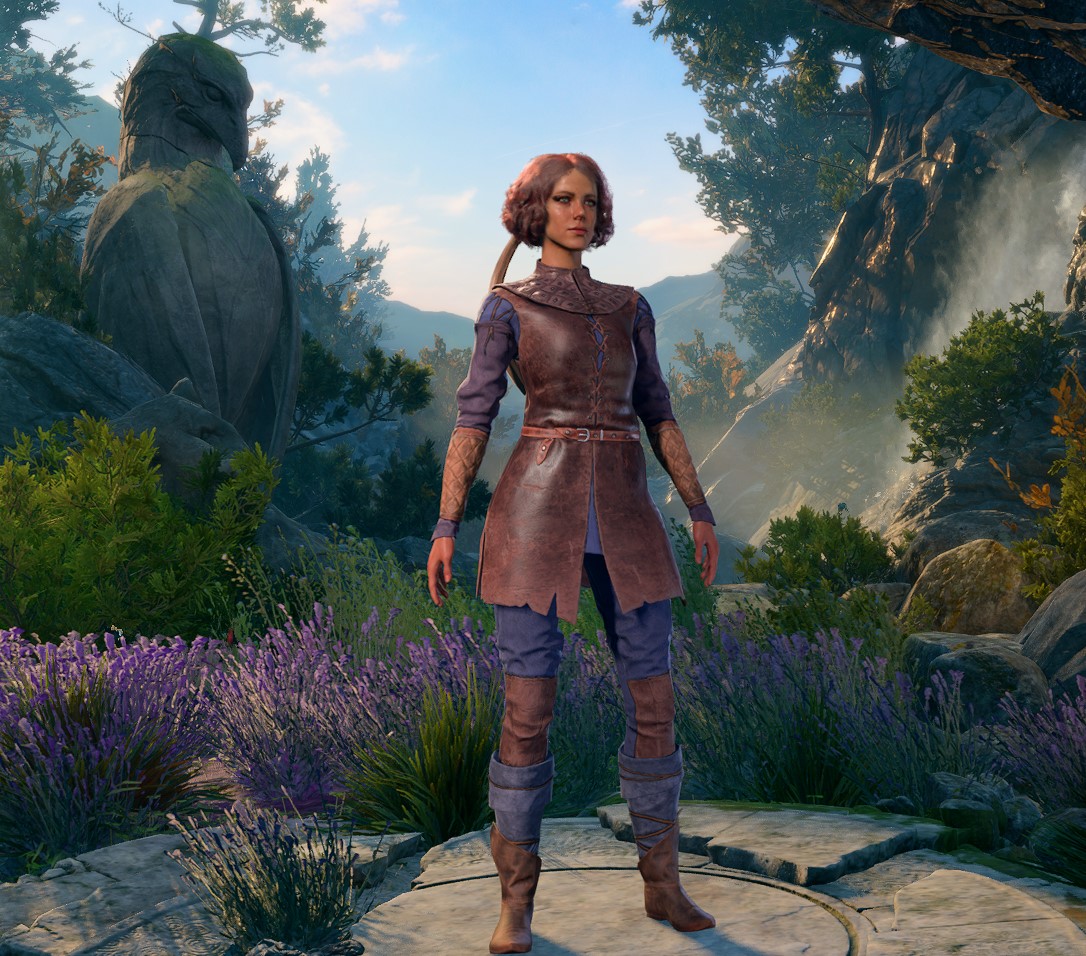
Wood Half-Elf is the best solo Rogue race because you gain Stealth proficiency, shield proficiency, and the highest movement speed of any race. The second choice is the Githyanki because of its Medium armour proficiency, Enhanced Leap, and Misty Step spell. Lastly, the Duergar is a good choice because you get the Enlarge and Invisibility spells.
Here is the best race choice for a solo Rogue build in Baldur’s Gate 3:
| Wood Half-Elf | Githyanki |
|---|---|
| Fleet of Foot (10.5m movement) | Martial Prodigy |
| Fey Ancestry | Misty Step Spell |
| Darkvision (12m) | Enhanced Leap Spell |
| Stealth Proficiency | Astral Knowledge |
The most important aspect of this racial selection is armor and weapon proficiency unlocks early. Since we will multi-class this build, the Rogue will eventually get medium armor and martial weapon proficiency. However, at the start of the game, using one hand and shield with ranged weapons dramatically increases your survivability. This is why we highly recommend the Wood Half-Elf to start.
Ability Score

The Best Ability Score for a solo Rogue Build is 17 Dexterity, 16 Constitution, and 14 Wisdom. Dexterity increases your range of weapon damage, initiative, and Armour Class (AC). Constitution gives you a higher health pool and concentration spells.
Below is the best ability score for a solo Rogue in Baldur’s Gate 3:
- Strength – 8
- Dexterity – 17
- Constitution – 16
- Intelligence – 8
- Wisdom – 14
- Charisma – 10
The important part to note is that your 17 Dexterity score can be pushed to 18 in Act 1. You’ll need to complete a quest with Auntie Ethel and choose a permanent +1 bonus. This is vital to get the most power out of the build. Moreover, you can then access the Mirror of Loss in Act 3 with Shadowheart quest, and possibly get another +2. Thus, you can only use one ability improvement feat to reach 20 Dexterity.
Make sure to check out our Permanent bonus guide on how you can boost your ability score through quests.
Background & Skills
The best Background for a solo Rogue is Urchin because you gain proficiency in Sleight of Hand and Stealth. Backgrounds in Baldur’s Gate 3 are a way to represent your character’s backstory and give them some starting skills and abilities.
The best skills are also Sleight of Hand and Stealth. However, look to increase Perception and Insight. These skills will help while exploring and finding chests and items in the open world.
Circle of the Land Druid Illithid Powers
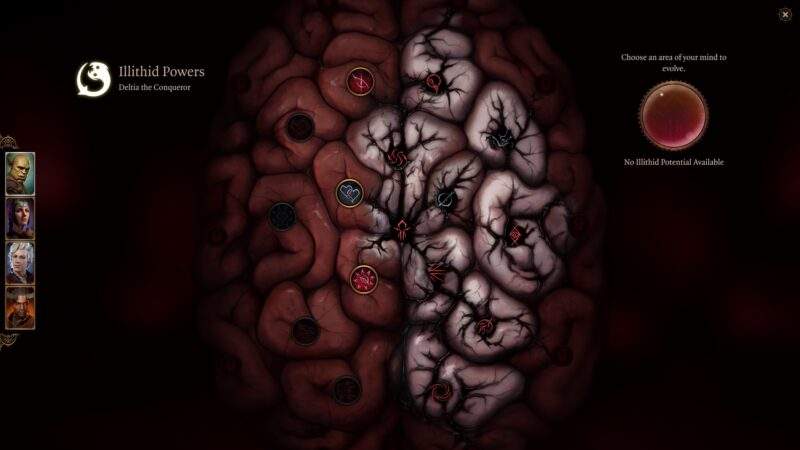
Illithid Powers are unlocked later in the game when you learn more about the Mind Flayers and Tadpoles. You can gain jars of Mind Flayer Parasite Specimens, and consume them to gain one point. This is essentially another skill tree advancement with some very strong powers. If you decide to advance this skill line, these are the choices we suggest.
Here are the best Illithid Powers for the Circle of the Land Druid Build:
| Illithid Powers | Description |
|---|---|
| Luck of the Far Realms | When you make a successful Attack Roll against a foe, you can change that hit into a Critical Hit. |
| Cull of the Weak | When you bring a creature down to fewer hit points than your number of evolved Illithid powers, it dies and all nearby creatures take 1-4 Psychic damage. |
| Psionic Backlash | When an enemy within 9m casts a spell, you can use your reaction to inflict ld4 Psychic damage to the caster per the spell’s level. |
| Blackhole | Area-based suck-in that slows targets. |
| Repulsor | Massive area knockback that can hit friendlies. |
| Charm | This is the priority power you want to obtain because you can force enemies to attack something else. |
Best Solo Rogue Build – Level Progression in Baldur’s Gate 3
| Level | Class | Selection |
|---|---|---|
| 1 | Rogue | Skill Expertise: Sleight of Hand, Stealth |
| 2 | Rogue | – |
| 3 | Rogue | Subclass: Theif |
| 4 | Rogue | Feat: Sharpshooter |
| 5 | Fighter | Archery Fighting Style |
| 6 | Fighter | – |
| 7 | Fighter | Battlemaster, Riposte, Precision Attack, Trip Attack |
| 8 | Fighter | Feat: Ability Improvement +2 Dex |
| 9 | Fighter | – |
| 10 | Ranger | Favored Enemy: Bounty Hunter, Natural Explorer: Wasteland Wanderer: Poison |
| 11 | Ranger | Defense Fighting Style Spells: Hunter’s Mark, Ensnaring Strike |
| 12 | Ranger | Subclass: Gloom Stalker Spell: Enhanced Leap |
Alternative Solo Rogue Build
For our alternative Solo Rogue build, we’re focusing on a more aggressive, melee-oriented playstyle. While you can still open fights with ranged sneak attacks for a strong burst of damage, the core of this build puts you up close and personal, relying heavily on melee combat once the fight begins.
By multiclassing into just the Fighter class, you’ll gain access to the Eldritch Knight subclass and the Booming Blade cantrip by Level 7. This also unlocks key Fighter features like Action Surge, Extra Attack, and three additional Feats, giving you a powerful mix of offense and versatility.
| Level | Class | Selection |
|---|---|---|
| 1 | Rogue | Sneak Attack (Ranged & Melee) |
| 2 | Rogue | Cunning Action: Hide |
| 3 | Rogue | Subclass: Thief |
| 4 | Rogue | Feat: Dual Wielder |
| 5 | Fighter | Multiclass: Fighter |
| 6 | Fighter | Action Surge |
| 7 | Fighter | Subclass: Eldritch Knight |
| 8 | Fighter | Feat: +2 Dexterity |
| 9 | Fighter | Extra Attack |
| 10 | Fighter | Feat: Alert |
| 11 | Fighter | Remarkable Athlete: Proficiency and Jump |
| 12 | Fighter | Feat: Savage Attack |
Level 1
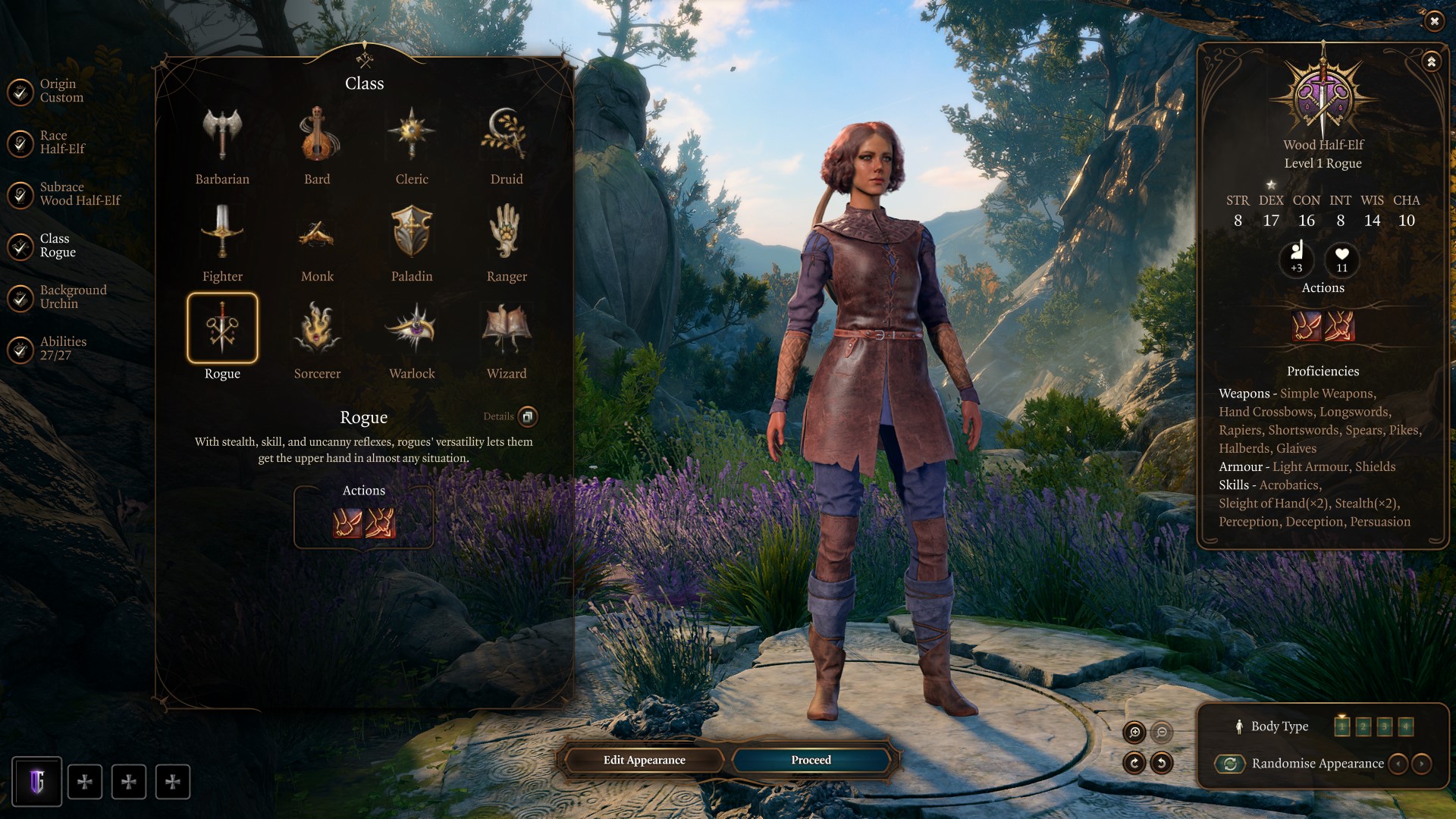
At level 1, you should follow our Solo Rogue Build character creation steps. Select the correct background, race, skills, and ability score focusing on Dexterity and Constitution. You won’t be able to pick your subclass until level 3, so expect a slow start in terms of performance. For this build, we will focus on the Rogue for 4 levels before switching to the Fighter. The Rogue will unlock an extra bonus action at level 3 and a feat at level 4. Beyond this, the class’s power fades so we will need to pick up 5 levels of Fighter for Extra Attack. Finally, we will transition to Gloom Stalker Ranger for the last 3 levels, using 3 classes to get the most power possible. Here’s what you unlock as a Level 1 Rogue:
Class Feature and Mechanics
- Sneak Attack (Ranged & Melee): Deal an additional to an enemy you have Advantage against. Attack/Save: Ranged Attack Recharge: Once per turn. To gain Advantage, you need to be hiding or that enemy to be engaged with another in 1.5 meters.
The Sneak Attack stands as a fundamental class feature for Rogues in Baldur’s Gate 3, enabling them to inflict additional damage on a target when they enjoy Advantage on the attack roll. The simplest means to gain Advantage involves initiating combat while in stealth or engaging with a target that is already under attack. In this specific build, the strategy involves always stealthing before engaging in combat. Moreover, you can spend a bonus action before ending your turn to go into stealth. You will gain cunning stealth next level and you want to make sure to always use all of your bonus actions per round in combat.
When configuring your Rogue, navigate to the reactions tab and select “ask” in reactions. This action triggers Sneak Attack damage if you haven’t used a regular attack, functioning akin to a Paladin’s Divine Smite by adding extra damage. This method ensures you consistently deal additional damage whenever the opportunity arises. Keep an eye out for the Advantage signal near your mouse when approaching an attack, indicating the ideal moment for Sneak Attack.
Weapon Choices
This Rogue build will use ranged damage which is dependent on your playstyle and starting race. The easiest to use is dual Handcross Bows +1 (preferred). The reason this is helpful as a Rogue is you gain an additional bonus action and can make use of the damage using your offhand Handcross bow. Moreover, Rogues have proficiency by default, and out of the gate, these can be strong.
The secondary choice is the Longbow, which you will not have proficiency in unless a Wood Elf (different than a Wood Half-Elf). One popular combination with our builds is the Titanstring Bow with Elixir of Hill Giant Strength and Gloves of Archery. This will deal a lot of damage, but won’t make use of your bonus action and will be difficult to obtain early in Act 1.
Lastly, we highly recommend using a Shield with a one-handed weapon if you choose Wood Half-Elf. For solo play, this increases your survivability dramatically, giving you a +2 to AC immediately. Moreover, the Glowing Shield can be obtained early in the game and it helps survivability without sacrificing damage.
In summary, we will suggest two Handcross Bows +1 and one hand and shield for this build, but you have the above reference if you wish to change.
Solo Rogue Gameplay & Priorities
Look to acquire Elixir of Hill Giant Strength, Potion of Speed, and Oil of Accuracy consumables. These three consumables “stack” allowing for massive damage! We’ve listed weapon and armor priorities, but here are some more.
Your overall priority with the Solo Rogue build is the following:
- Complete Prologue
- Recruit Companions
- Unlock Withers, respec companions to proper class/ability score
- Collect the Necromancy of Thay (important in Act 3)
- Reached Hollowed City/Druid Grove
- Sell, Stock up, complete quests
- Unlock summons, Scratch, Shovel
- Progress to level 5
- Reach Underdark and Grymforge
- Check all Permanent Bonuses in Act 1 and the best Gear
- Act 1 Checklist for step-by-step completion
Level 2
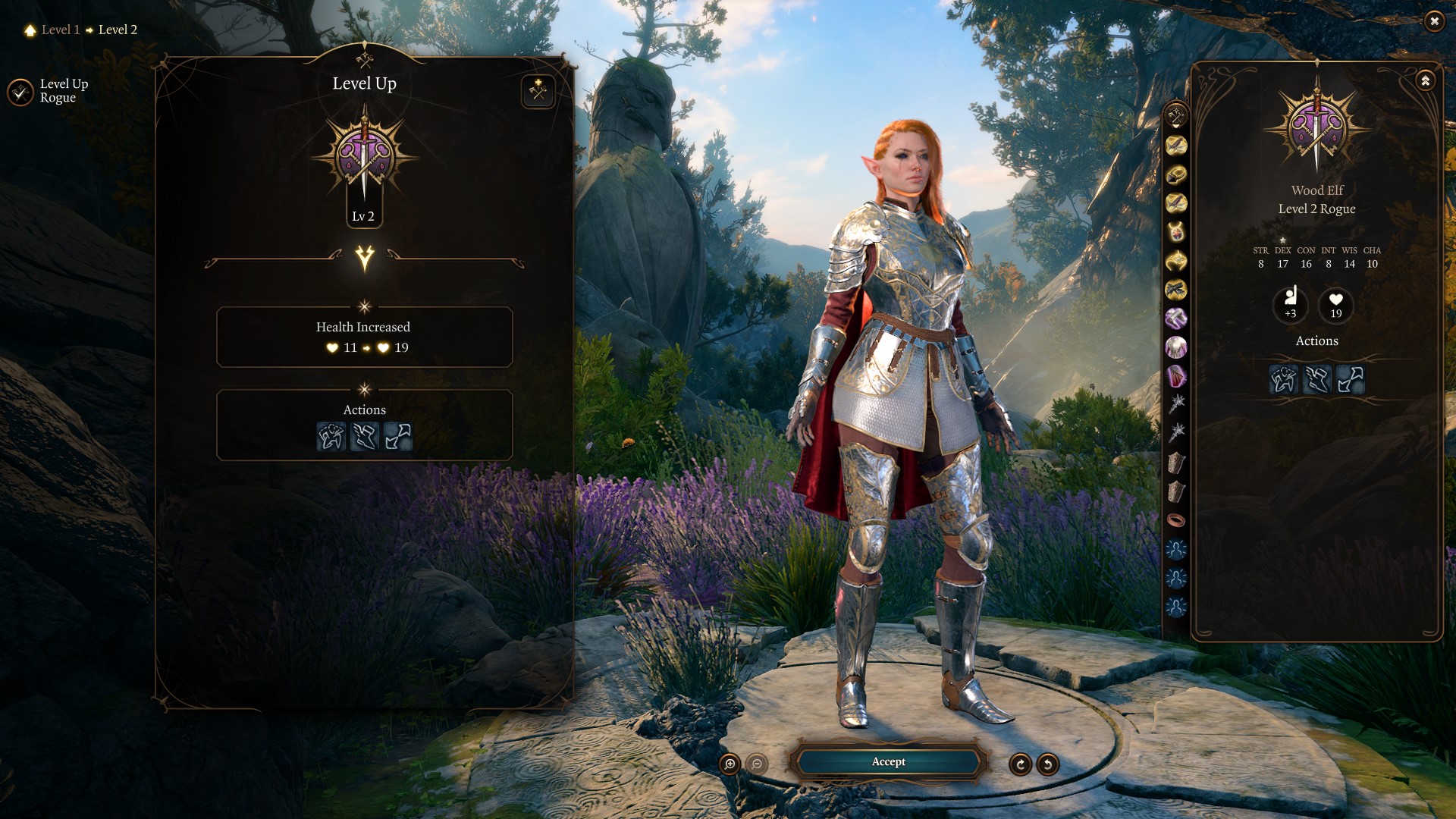
At Level 2, you will unlock the Cunning Action class feature, more health, and one more level until subclass choice.
- Cunning Action Hide: Hide from enemies by succeeding Stealth checks. Stick to the dark and avoid enemy sightlines.
- Cunning Action Dash: Cover more distance this turn: double your Movement Speed.
- Cunning Action Disengage: Retreat safely: moving won’t provoke Opportunity Attacks.
This gives you the ability to use Dash, Hide, and Disengage as a bonus action. Bonus actions are the theme of Rogue and Thief, giving you much greater utility with them and allowing your action to be used solely for attacking. The best use of the bonus action is setting up your next turn in stealth. You can open up then retreat if not already engaged and Hide. If undetected, you will be able to open up with a Sneak Attack doing more damage. Also try to use your bonus action, either from Cunning Action, potion, poison, or anything that aids you in combat.
Combat at this level usually revolves around you closing into range on turn one and opening up. If you can attack with your action, or hide with a bonus action, your next turn will be even better. Look to use Oils and Poisons outside of combat that last until a Long Rest to increase your damage.
Level 3
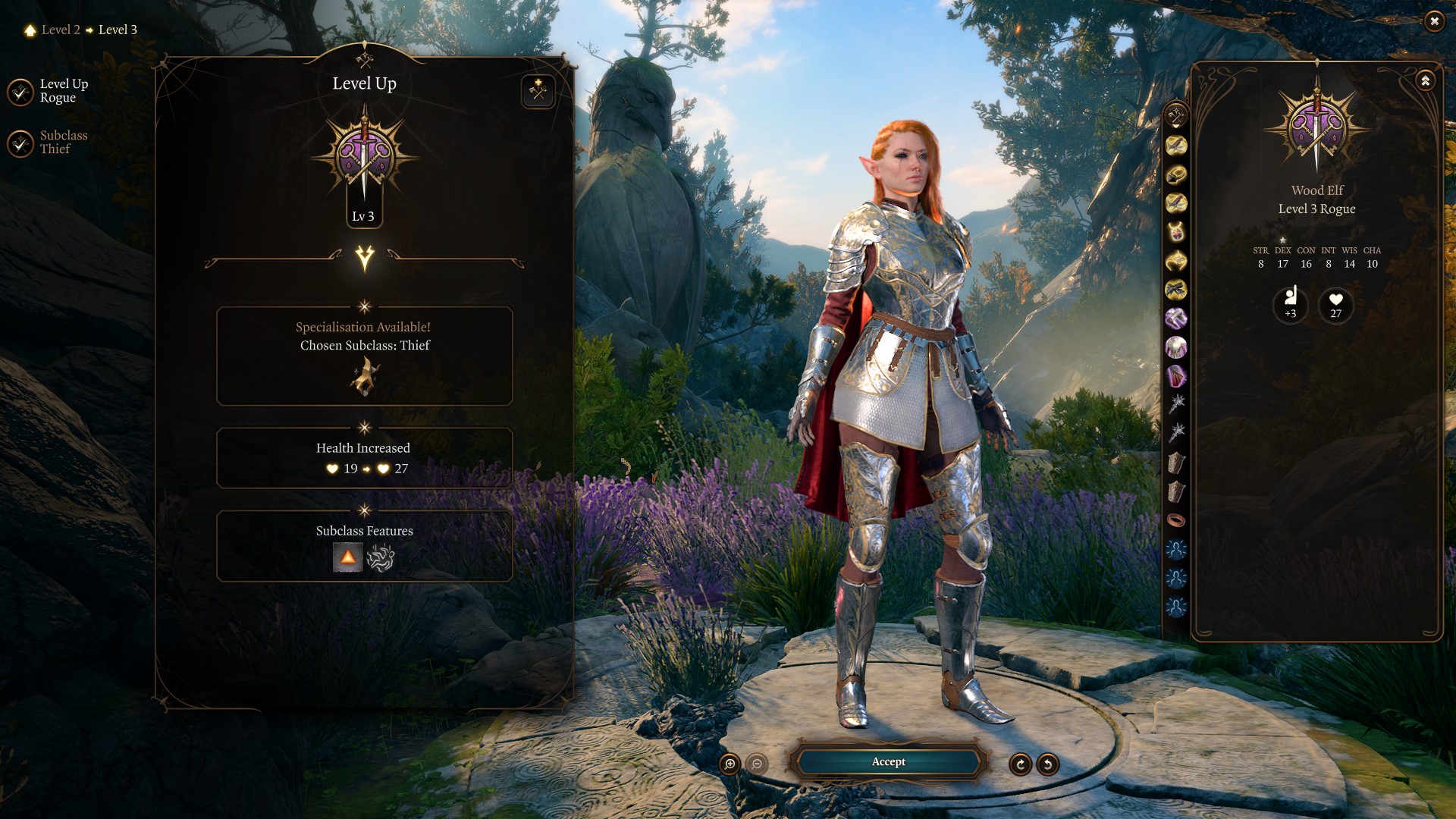
At Level 3, you can pick your subclass and we recommend the Thief. Here’s what you can expect from the Thief Subclass until max Level 12 in Baldur’s Gate 3:
- Fast Hands (Level 3): Gain an additional bonus action.
- Second-Story Work (Level 3): You’ve mastered the art of falling and gaining Resistance to Falling damage.
With two bonus actions, you can use one to hide and get Advantage. The second one is usually for dash, potion, poison on the weapon, etc. However, if you have dual handcross bows at this point, each attack will use an action and a bonus action. Moreover, your secondary weapon can use a bonus action to attack for even more damage.
Don’t be afraid to use arrows with elemental properties constantly at this stage of the game. You have nearly zero ways to crowd control enemies outside of arrows and Smokepowered Bombs. Ice Arrows are my favorite early on, which can knock enemies prone. We will list a series of them below, but don’t hold on to 12 Ice Arrows! This build lacks crowd control and using Arrows, including Roaring Thunder for knockback is how you get around it at early levels.
Level 4
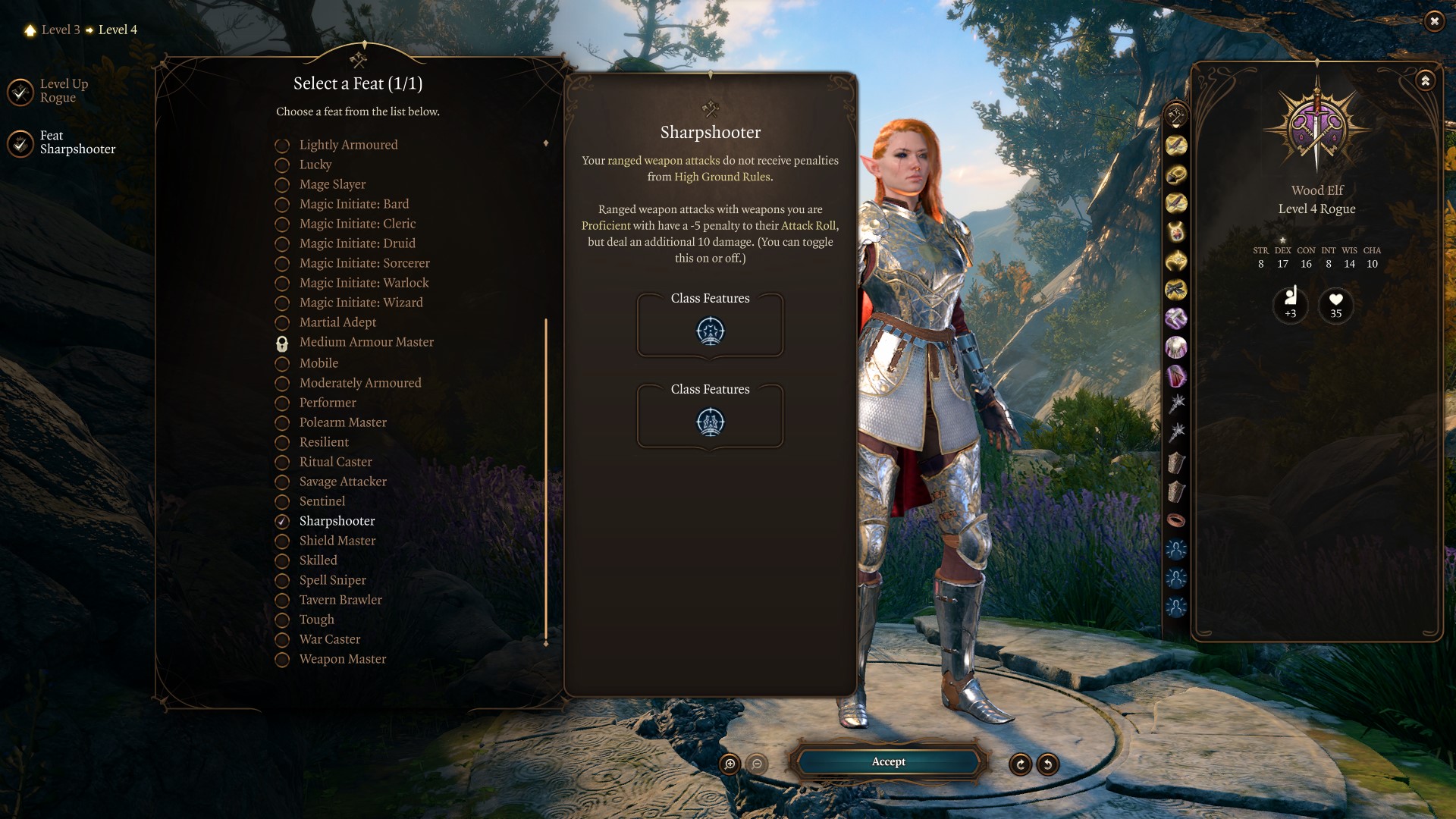
Upon reaching Level 4, a pivotal decision awaits—choosing between a feat and an Ability Improvement. We strongly recommend opting for the Sharpshooter feat over the Ability Improvement. This feat exempts your ranged weapon attacks from penalties related to High Ground Rules. Although there’s a -5 penalty to the Attack Roll for ranged weapon attacks with proficient weapons, they gain an additional 10 damage.
The Sharpshooter feat significantly enhances your damage output and spares you from drawbacks when lacking a height advantage. Admittedly, this might reduce your chance to hit, especially in the early stages of the game with lower ability scores and gear. You can mitigate this by toggling off the penalty via the passives on the toolbar while still benefiting from high-ground rules. Spells like Blessed, Elixir of Heroism, or increasing your Dexterity, and actively seeking the Gloves of Dexterity gear set all help mitigate the lower chance to hit.
This build will only get one more feat, which we will use for ability improvement to reach 20 Dexterity.
Level 5

At level 5, we suggest switching to the Fighter class. To do this, simply click the + sign with two access for multiclass. Select your class then a popup will appear on what you can select. The reason why is, that the Rogue diminishes greatly in terms of combat performance. What it’s lacking is Extra Attack, giving you two attacks per action. Combine Extra Attack with two bonus actions you can do some serious damage. Below is what you unlock with one level into Fighter:
- Archery Fighting Style: gain a +2 bonus to Attack rolls you make with ranged Weapons.
- Second Wind: One per short rest, you can regain 1d10 + Level HP.
The only benefit here is Archery Fighting Style which helps our ranged damage build. Next level we get Action Surge which will help our combat power even more.
Level 6
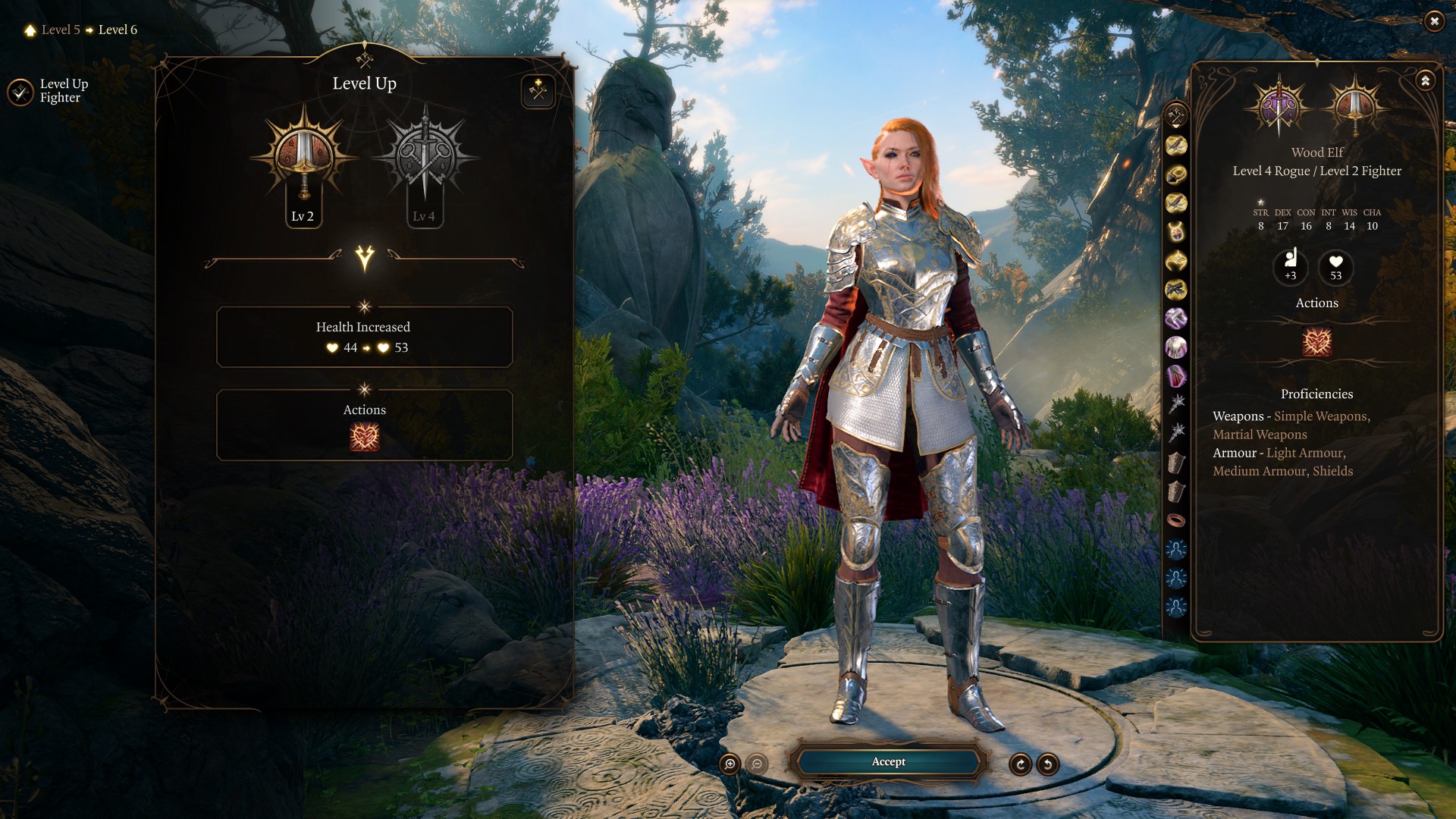
At level 6, with two levels of investment into the Fighter, you unlock Action Surge: Immediately gain an extra Action to use this turn. At this level, you should feel pretty powerful being able to get two actions and two bonus actions on turn one. You can combine a potion of speed or Bloodlust Elixir for even more actions and thus even more damage. The only missing ingredient here is Extra Attack which is coming soon.
Ending Act 1 with the Solo Rogue
By the time you get to Level 6 with the Solo Rogue BG3, you should be close to finishing Act 1 content. Be sure to visit vendors again and stock up on camp and alchemy supplies. Moreover, check out the best Act 1 items. Additionally, you don’t want to miss the permanent bonuses you can acquire in Act 1. Lastly, Grymforge has powerful armor and weapons (Adamantine) that can aid you well into Act 3. Consider taking the time to craft a couple of items there before transitioning to Act 2, when you won’t be able to return to this map.
Level 7
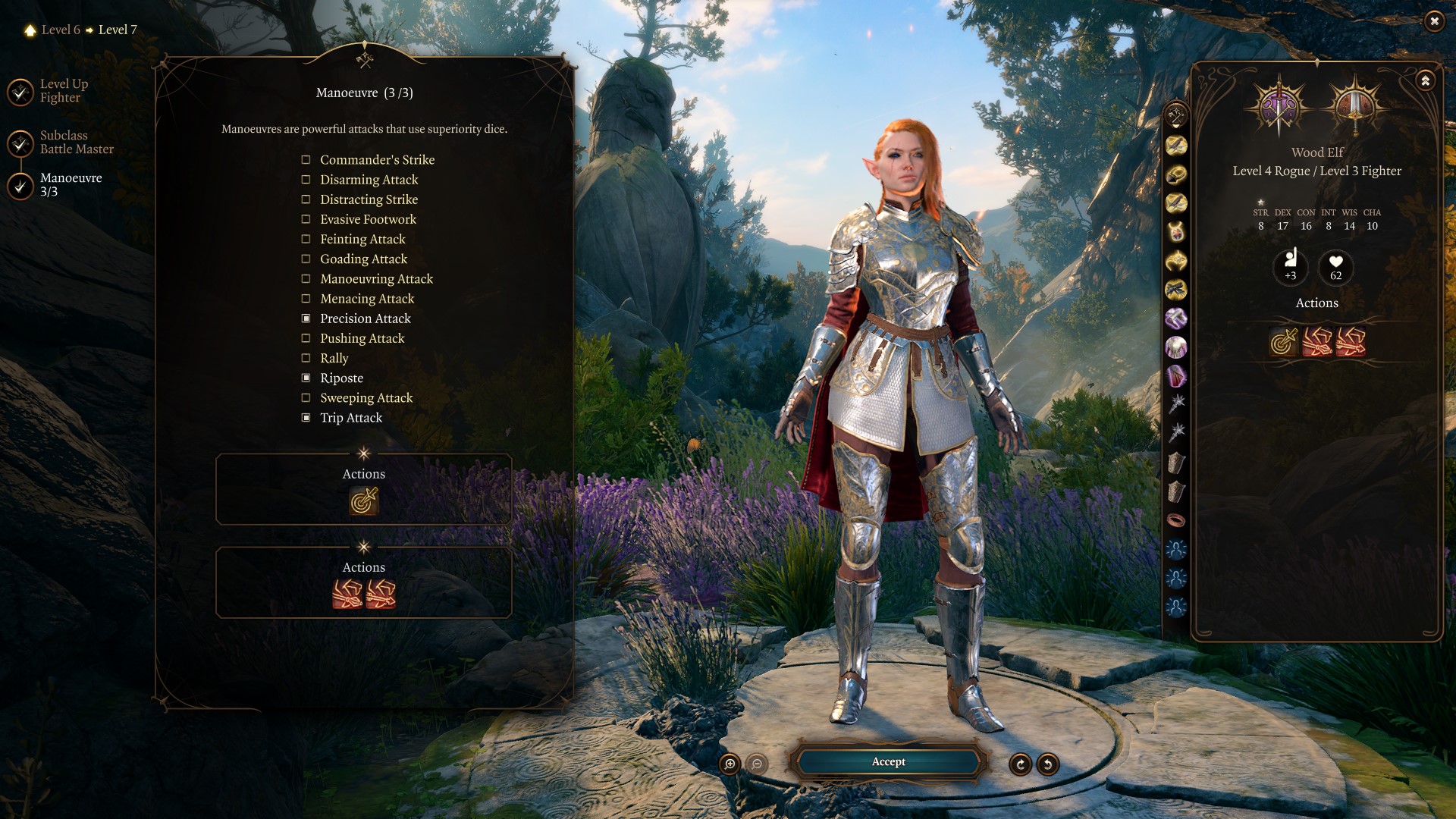
At level 7, you unlock the Battle Master Subclass with the Fighter. This is a big help to overall damage and crowd control. The Battle Master subclass unlocks a new resource called Superiority Dice (4 of them per short rest). You can spend these to augment and enhance certain weapon attacks or add new ones. Below is our suggestion for the Best Baldur’s Gate 3 Solo Rogue Build:
- Riposte: When a hostile creature misses you with a melee attack, expend a superiority die to retaliate with a powerful attack that deals an additional 1d8 Physical damage.
- Precision Attack: Spend a Superiority Die and add its result to an Attack Roll.
- Trip Attack: Spend a superiority die to make an attack that deals an additional 1d8 Physical damage and possibly knocks the target Prone. The target must be Large or smaller.
Riposte is helpful playing solo with a Shield and higher AC because enemies will miss you and you can do free damage with a reaction. Precious Attack simply adds a bit of damage and doesn’t require an action or bonus action. Use this when you need to unload turn one or need a few more damage for a kill. Lastly, Trip Attack is a great crowd-control ranged weapon attack. You can use this in conjunction with Ice Arrows to control and knock down enemies to prevent incoming damage back at you.
Level 8

At level 8, you will unlock another feat. At this point, we suggest a +2 Ability Score into Dexterity. The picture above shows 19 because this character did not complete Auntie Ethel’s quest in Act 1. Make sure you do so you can get an extra ability score permanently!
Another suggestion at this level is the Alert feat. This prevents you from being surprised, which can end your campaign outright, especially in Act 2. Take this feat if you plan and are familiar with the Mirror of Loss Act 3 dialogue options. If you are playing on Honour Mode, you won’t be able to load or save scum the DC 25 checks and it’s unlikely you will pass them. Thus, Alert is a defensive feat if you are hyperparamoid with dying, or Dexterity +2 for more damage.
Level 9
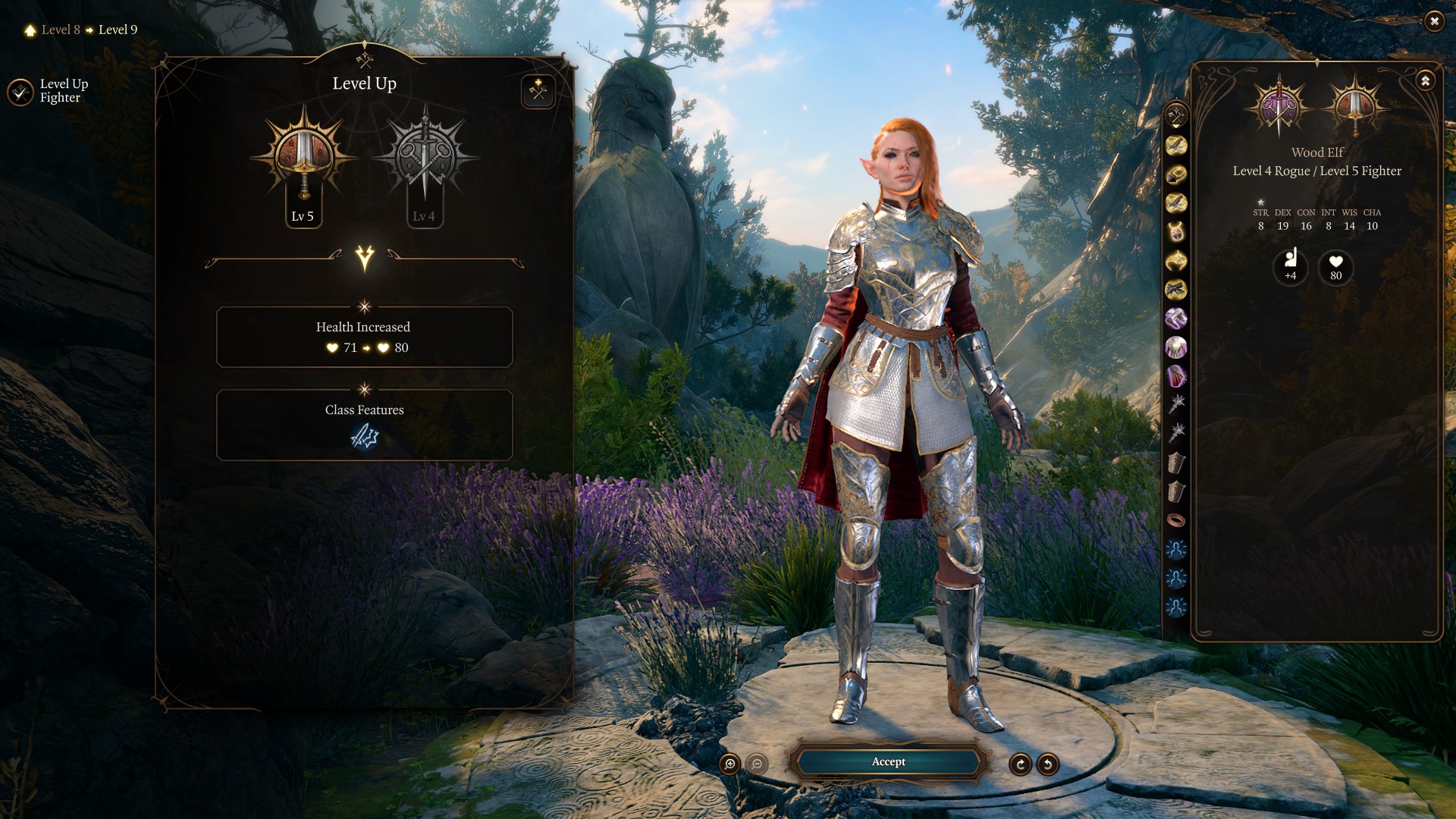
At level 9, with 5 levels of investment into the fighter, you unlock Extra Attack: You can attack twice, instead of once, whenever you take the Attack action on your turn. Now, each action will give you two attacks. If you still use Dual Crossbows, this will sync up well with additional bonus actions. Moreover, if you combine poison and oils on your Handcross bows, expect big damage. One common method is using Oil of Combustion with Fire Arrows. Oil of Combustion doused the target in oil for 2 turns. If it takes Fire damage, the oil immolates, dealing 3d6 fire damage in an area around it. This creates massive area-based kills and is perfect for playing solo Rogue.
Level 10
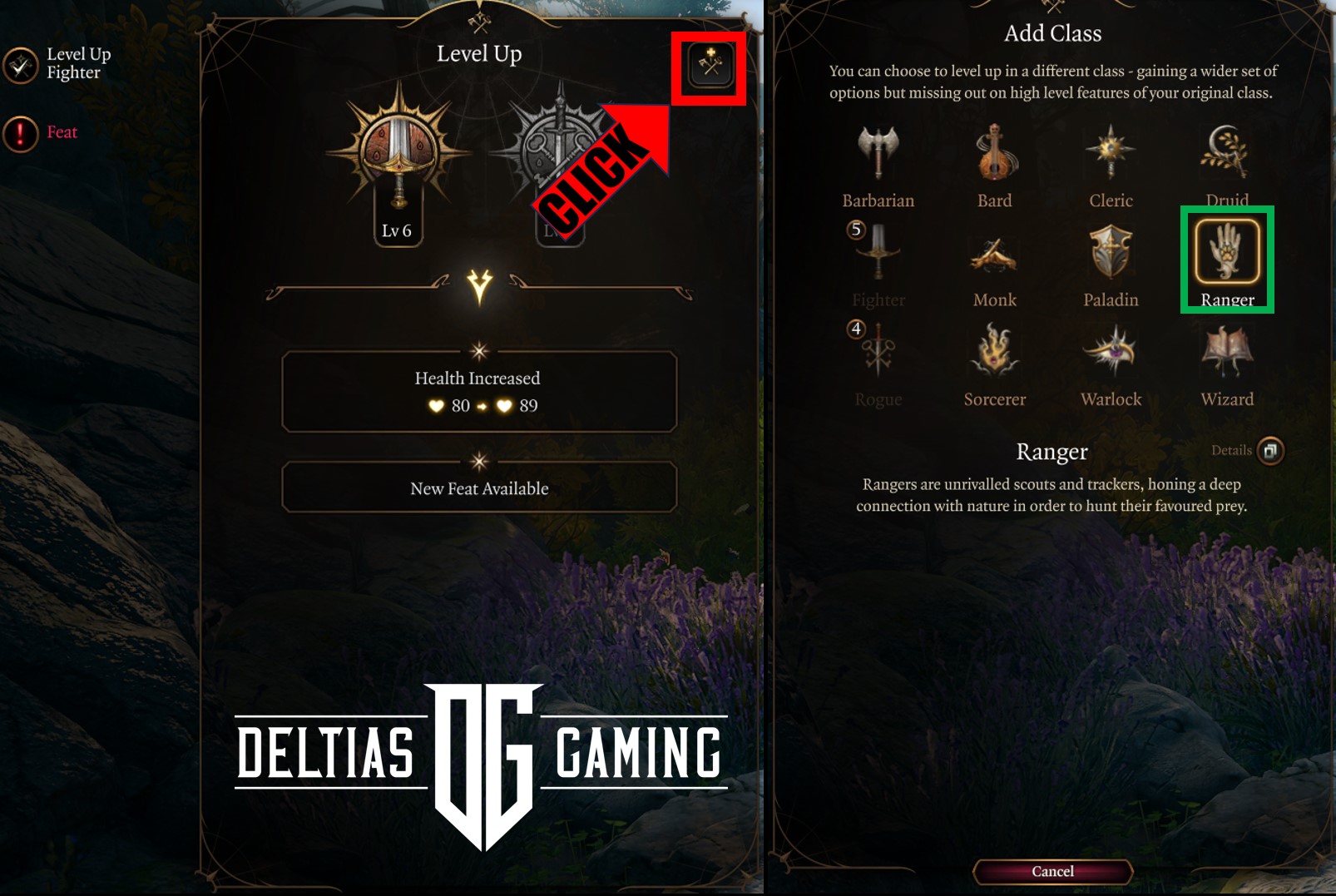
At level 10, we suggest switching to the Ranger class. To do this, simply click the + sign with two access for multiclass. Select your class then a popup will appear on what you can select. The reason we want to use the Ranger is spell casting in conjunction with Hunter’s Mark and other useful spells. Moreover, the Gloom Stalker subclass gives us a massive benefit on turn one, which is helpful when playing solo. Below are our suggestions at this level:
- Favoured Enemy: Bounty Hunter (class feature): Gain Proficiency in Investigation. Creatures you hit with Ensnaring Strike have Disadvantage on their Saving Throw.
- Natural Explore: Wasteland Wanderer: Poison (class feature): Gain resistance to Poison, taking only half damage from it.
The Bounty Hunter selection helps when using Ensnaring Strike on a target, while Poison resistance is a nice benefit passively. Fire and Cold resistance are easy to obtain thus Poison is a strong choice here.
Level 11
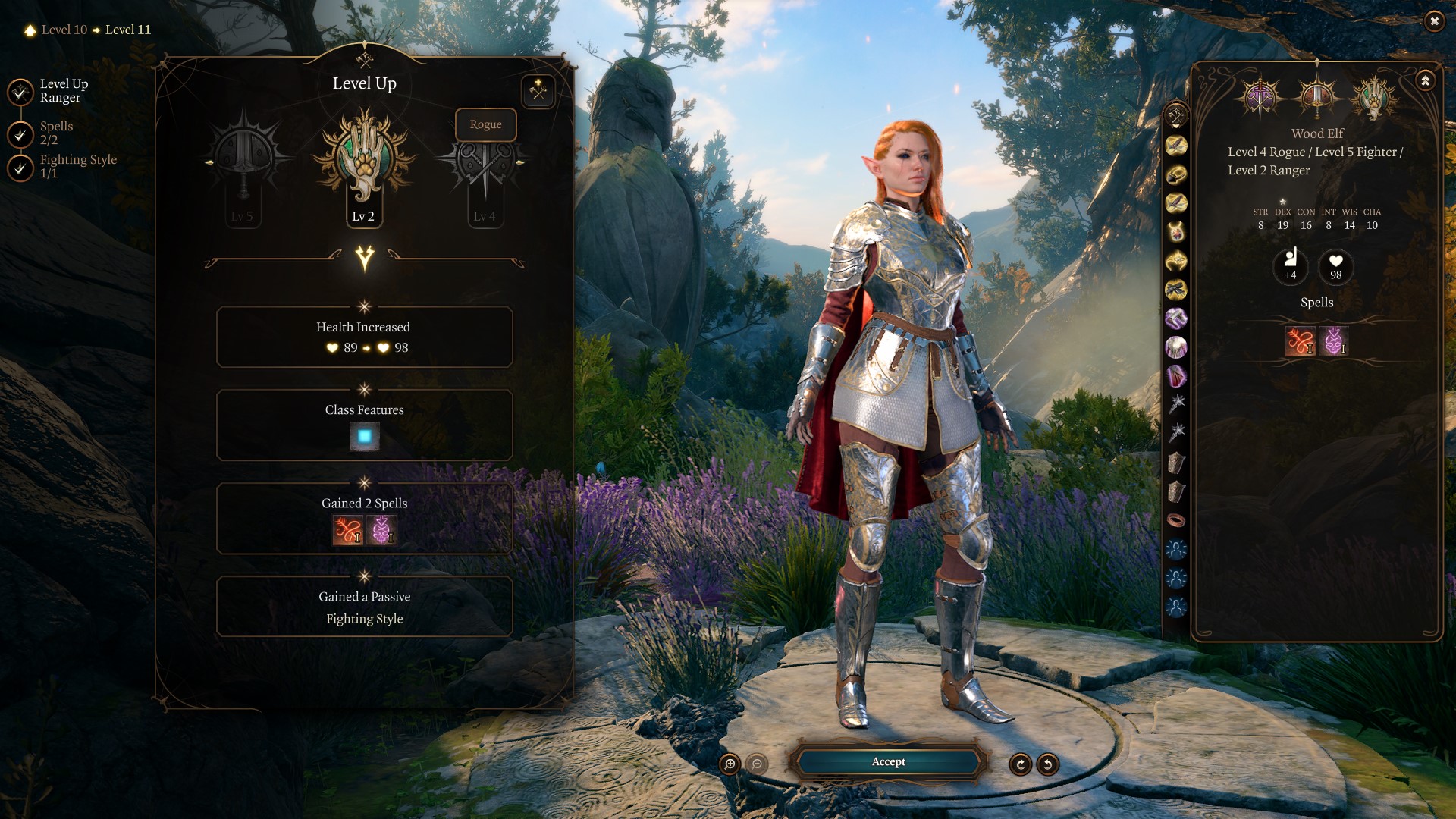
At level 11, the Solo Rogue build you will unlock a Fighting style, two spells, and spell casting. Below are our recommended selections:
- Hunter’s Mark (spell selection): Mark a creature as your quarry to deal an additional 1~6 whenever you hit it with a weapon attack.
- Ensnaring Strike (spell selection): Your attack summons thorny vines that possibly Ensnare your target.
- Defence Fighting Style (class feature): Gain a +1 bonus to Armour Class while wearing Armour.
Now your Rogue will have access to powerful spells and even more AC while wearing armour.
Hunter’s Mark, a powerful ability, consumes a bonus action to mark a target, increasing the damage you deal to them. The great thing about this ability is that you can reapply it to a new target without spending another spell slot after the first target dies. This makes Hunter’s Mark a valuable tool for conserving resources and maximizing damage output. Typically, Hunter’s Mark is used as a bonus action on the first turn of combat.
Ensnaring Strike, another useful spell, can be used to immobilize a single target. This can be a strategic advantage, but it’s important to use it sparingly due to its resource cost and the risk of concentration being broken. Reserve Ensnaring Strike for situations where preventing an enemy from reaching you or an ally is crucial.
Level 12

At level 3, the Best Solo Rogue build unlocks a subclass selection and Gloom Stalker is the best choice. Below are the skills and tools you unlock at this level and how to use them:
- Gloom Stalker (subclass): Specialize in taking out foes swiftly and ruthlessly from the shadows, gaining damage bonuses and increased movement speed.
- Enhanced Leap (spell selection): Triple a creature’s Jumping distance for 10 turns.
- Dread Ambusher (subclass feature): Gain a +3 bonus to Initiative. On the first combat turn, your movement speed increases by 3m, and you can make an attack that deals an additional 1d8 damage.
- Superior Darkvision (subclass feature): can see up to 24m in the dark.
- Umbral Shroud (subclass feature): Wrap yourself in shadows to become Invisible if you are obscured.
- Dread Ambusher (subclass feature): Hide: use a bonus action to hide from enemies though attacking or casting breaks this.
- Umbral Shroud (subclass feature): Become invisible for 10 turns, ends if you attack or cast another spell.
- Disguise Self (subclass spell): change your character’s appearance.
Gloom Stalker Playstyle
Dread Ambusher grants a free attack on turn one. Locate the icon on the far right of your toolbar, which appears without consuming an action or a bonus action. This feature pairs exceptionally well with Hunter’s Mark on the first turn. Additionally, Dread Ambusher allows you to hide as a bonus action, providing various options for bonus action utility. Umbral Shroud serves as a getaway tool, although Invisibility potions are often preferred for their reliability.
With these utility options, emphasis should be placed on your first turn. The goal is to eliminate, stun, crowd control, or immobilize the most damage-producing target. Consider combining Dread Ambusher with Superiority Dice for extra damage. As always, you should be initiating combat from stealth when possible. If you feel overwhelmed on turn one, use an invisibility potion and flee.
Continue below for gear recommendations using the best Baldur’s Gate 3 Solo Rogue Build.
Related:
Best Gear for Baldur’s Gate 3 Solo Rogue Build
In Games like Baldur’s Gate 3, you’ll explore the world, loot chests and your enemies’ dead bodies, and complete quests and all those activities can reward you with useful items, potions, armour, weapons, scrolls, and much more. There are three Acts in BG3, and Best Baldur’s Gate 3 solo Rogue Build Guide includes suggested sets and alternatives for Act 1 and Act 3.
Beginner: Starting the Game
Here’s the best beginner gear, items, and equipment for the best Rogue Build in Baldur’s Gate 3:
| Gear Slot | Best Gear Item | Effect |
|---|---|---|
| Head | Shadow of Menzoberranzan | Invisibility skill |
| Cape | – | |
| Chest | Drow Studded Leather Armour | 12 AC, +1 Stealth |
| Gloves | Gloves of Archery | +2 Ranged Damage |
| Boots | Disintegrating Night Walkers | Free Misty Step |
| Necklace | Moondrop Pendant | No Opportunity Attacks |
| Ring | Caustic Band | +2 Acid Damage |
| Ring | Fetish of Callarduran Smoothhands | Free Invisibility Spell |
| Weapon 1 Main Hand | Club of Hill Giant Strength | 19 Strength |
| Weapon 1 Off-Hand | Adamantine Shield | +2 AC |
| Weapon 2 Range Main | Hand Crossbow +1 | 1d6 +1 Piercing |
| Weapon 2 Range Off-Hand | Hand Crossbow +1 | 1d6 +1 Piercing |
- Shadow of Menzoberranzan: Looted from the Pale Corpse in the Myconid Colony, Underdark (Alternative Haste Helm).
- Drow Studded Leather Armour: Inside a Heavy Chest at Lolth’s Cultist’s Cache in Underdark (Alternatives medium Adamantine Scale Mail, or Hide +2 Armour).
- Gloves of Archery: Sold by Grat the in the Goblin Camp (Alternatives Gloves of Dexterity, Gloves of Missile Snaring, or Gloves of Hail of Thorns).
- Disintegrating Night Walkers: Looted or stolen from Nere in Grymforge (Alternatives Boots of Striding, or Boots of Genial Striding).
- Moondrop Pendant: Sealed chest inside the Owlbear Nest (Alternatives Amulet of Branding, Amulet of Misty Step, or Amulet of Restoration).
- Caustic Band: Buy it from Derryth in the Myconid colony, Underdark (Alternative The Sparkswall).
- Fetish of Callarduran Smoothhands: Looted from dead gnomes in Grymforge X: -610 Y: 408 (Alternative Strange Conduit Ring, Ring of Absolute Force).
- Club of Hill Giant Strength: Found in Arcane Tower under Stool top level (Alternatives Hunter’s Dagger, or Knife of the Undermountain King).
- Adamantine Shield: Crafted in the Adamantine Forge (Alternatives Glowing Shield, or Wood Woad Shield).
- Hand Crossbow +1: Sold from various vendors in Act 1.
Longbow Setup
- Titanstring Bow: Brem in Zhentarim Hideout Act 1 (Alternatives Bow of Banshee, Spellthief, or Joltshooter).
Advanced: Endgame
Here’s the best endgame Act 3 gear, items, and equipment for solo Rogue Build in Baldur’s Gate 3:
| Gear Slot | Best Gear Item | Effect |
|---|---|---|
| Head | Helm of Balduran | Cannot be Stunned |
| Cape | Cloak of Protection | +1 AC |
| Chest | Helldusk Armour | 21 AC |
| Gloves | Legacy of the Masters | +2 Attack Roll |
| Boots | Helldusk Boots | Cannot be Moved |
| Necklace | Surgeon’s Subjugation Amulet | Stun on Crit |
| Ring | Killer’s Sweetheart | Auto Critical |
| Ring | Ring of Regeneration | Self-healing |
| Weapon 1 Main Hand | Blood of Lathander | Automatic Revive |
| Weapon 1 Off-Hand | Viconia’s Walking Fortress | +3 AC |
| Weapon 2 Range Main | Hellfire Hand Crossbow | +2 Hand Crossbow |
| Weapon 2 Range Off-hand | Ne’er Misser | +1 Hand Crossbow |
- Helm of Balduran: Found in Dragon’s Sanctum X: 636 Y: -964 (alternatives Helldusk Helmet, Sarevok’s Horned Helmet, Mask of Soul Perception, or Circlet of Hunting).
- Cloak of Protection: Sold by Talli Quartermaster at Last Light Inn Act 2 (alternative Shade-Slayer Cloak).
- Helldusk Armour: Looted from fighting Raphael House of Hope (alternative Armour of Agility, Dark Justiciar Half-Plate, or Flame Enamelled Armour).
- Legacy of the Masters: Sold by Dammon in Lower City, Forge of the Nine (alternatives Gloves of Soul Catching, Helldusk Gloves, or Gloves of Dexterity).
- Helldusk Boots: Wyrm’s Rock Fortress X: -32 Y: 219 (alternative Disintegration Night Walkers).
- Surgeon’s Subjugation Amulet: Looted from Malus Thorm at the House of Healing (alternative: Amulet of Greater Health, or Periapt of Wound Closure).
- Killer’s Sweetheart: Found in Self-Same Trial inside the Gauntlet of Shar (alternative Risky Ring).
- Ring of Regeneration: Found in Lorroakan’s Projection store (alternative Shifting Corpus Ring, or Ring of Free Action).
- Blood of Lathander: Act 1 and 2 Quest ( Alternative Crimson Mischief in main hand with Bloodthirst in off-hand).
- Viconia’s Walking Fortress: Looted from Viconia DeVir, Act 3 (Alternative Shield of Devotion).
- Hellfire Hand Crossbow: Looted from Yurgir in the Gauntlet of Shar X: -653 Y: -764 (Alternative Hand Crossbow +2).
- Ne’er Misser: Sold by Roah Moonglow in Moonrise Towers (Alternative Hand Crossbow +2).
Longbow Setup
- Gontr Mael: Looted from the Steel Watcher Titan in Steel Watch Foundry (alternative The Dead Shot).
Best Consumables, Potions, Ammunition, and Items
Consumables are items that can be used once and then destroyed. They are typically used to restore health or other resources. Some common types of consumables include potions, scrolls, food, drinks, and arrows.
The following list represents the best individual use consumable items that will aid in our Best Baldur’s Gate 3 Solo Rogue Build:
- Elixir of Hill Giant Strength: Increases Strength ability score to 21 until Long Rest.
- Elixir of Cloud Giant Strength: Increases Strength ability score to 27 until Long Rest.
- Elixir of Bloodlust: Once per turn when you kill a foe, you gain HP 5 temporary hit points and an additional action.
- Potion of Speed: Gain extra action, +2 AC, Advantage on Dexterity Saving Throws, and double movement speed.
- Drow Poison: Weapon poison that adds Constitution Saving Throw or becomes Poisoned and falls Asleep.
- Potion of Flying: Drink to gain a flying speed of 60ft for one hour.
- Elixir of Heroism: Gain 10 temp HP and become Blessed until a long rest.
- Oil of Accuracy: Coat Weapon. Bonus of +2 in Attack Rolls.
- Elixir of Vigilance: Drink to gain a +5 bonus to Initiative and you can’t be Surprised.
Ammunition
The best Ammunition for the Solo Rogue Build is listed below:
- Arrow of Ice: Deals weapon damage + 2d4 Cold and creates ice surface for 2 turns in a 2m radius.
- Arrow of Roaring Thunder: deals weapon damage, knocks back 5 meters if failed strength throw.
- Arrow of Many Targets: Deals weapon damage and an additional half of that damage to three other targets in range.
- Arrow of Dragon/Aberration/Humanoid: Deals weapon damage, and double damage against Dragon, Aberration, or Humanoid.
- Arrow of Salving: Cures a target of poisoned, paralyzed, and blinded conditions.
- Arrow of Transposition: teleports the shooter wherever this arrow is fired.
Permanent Bonuses
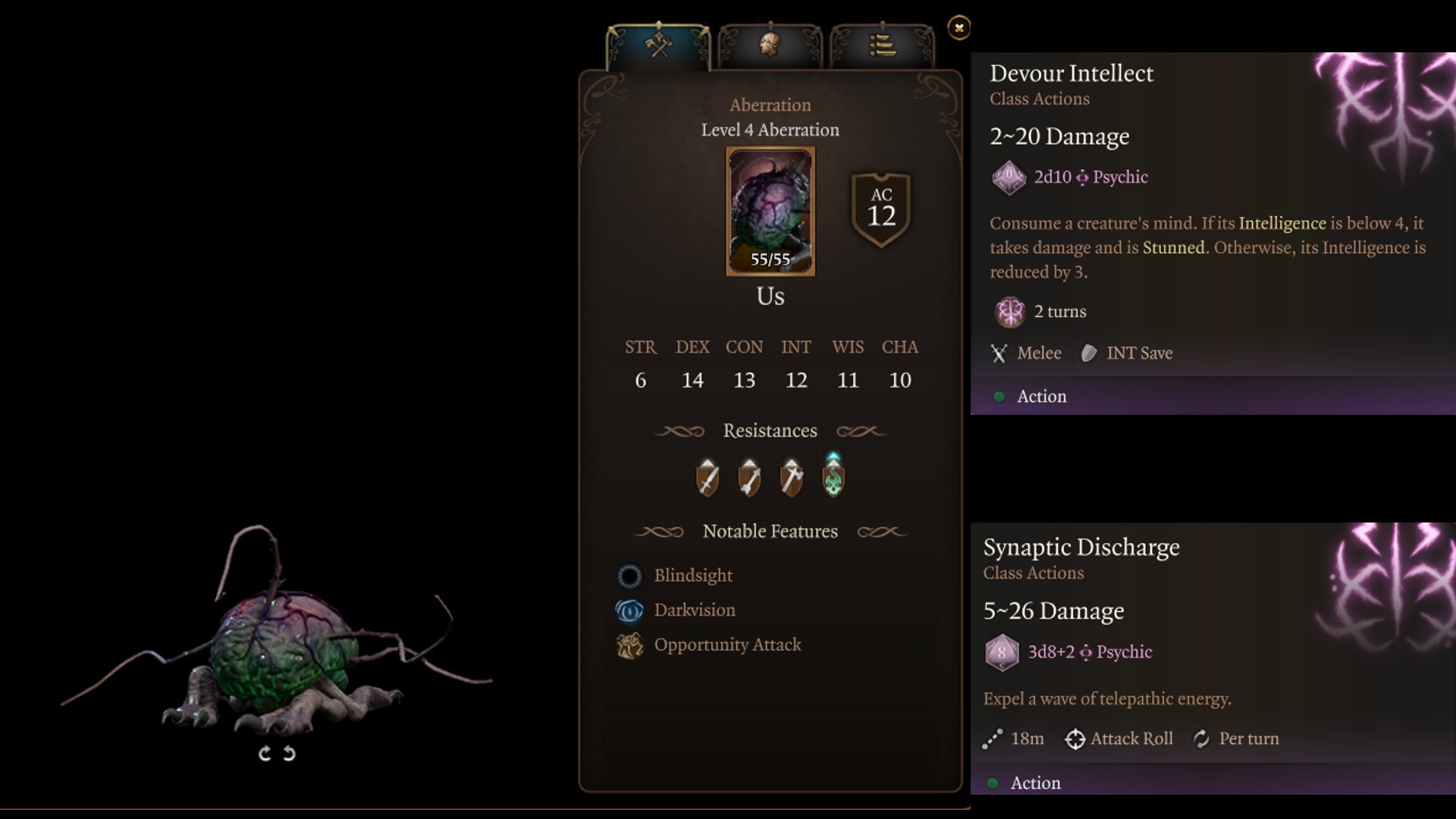
Throughout Baldur’s Gate 3, you will have the ability to gain permanent bonuses to your character. These can grant additional spells, ability scores, and other bonuses. Permanent Bonuses are not displayed throughout the campaign but are vital to increase overall combat performance. We have all permanent bonuses here in a guide, but the most important ones for you to collect are listed below.
| Act 1 | Act 2 | Act 3 |
|---|---|---|
| Auntie Ethel’s Hair: Gain +1 to an Ability Score. | Potion of Everlasting Vigour: Gain +2 Strength. | Mirror of Loss – +2 to an Ability Score of your choice. |
| Awakened: Use illithid powers as a Bonus Action. | Slayer Form: Ability to transform into the Slayer. | Partial Ceremorphosis: Access to tier 3 illithid Powers. |
| Scratch: Gain Find Familiar Scratch. | Summon Us: Allows you to summon Us. | Sweet Stone Features: Blessed permanent. |
| Cheeky Quasit: Gain Summon Quasit Shovel. | Statue of the Gods: +2 to Saving Throws | |
| Loviatar’s Love: 30% Hit Points or less, you gain a +2 bonus to Attack Rolls and Wisdom saving throws. | ||
| Necromancy Of Thay: access to powerful spells in Act 3. | ||
| Volo’s Ersatz Eye: See Invisibility |
Solo Rogue Build Changes in Patch 7 for BG3
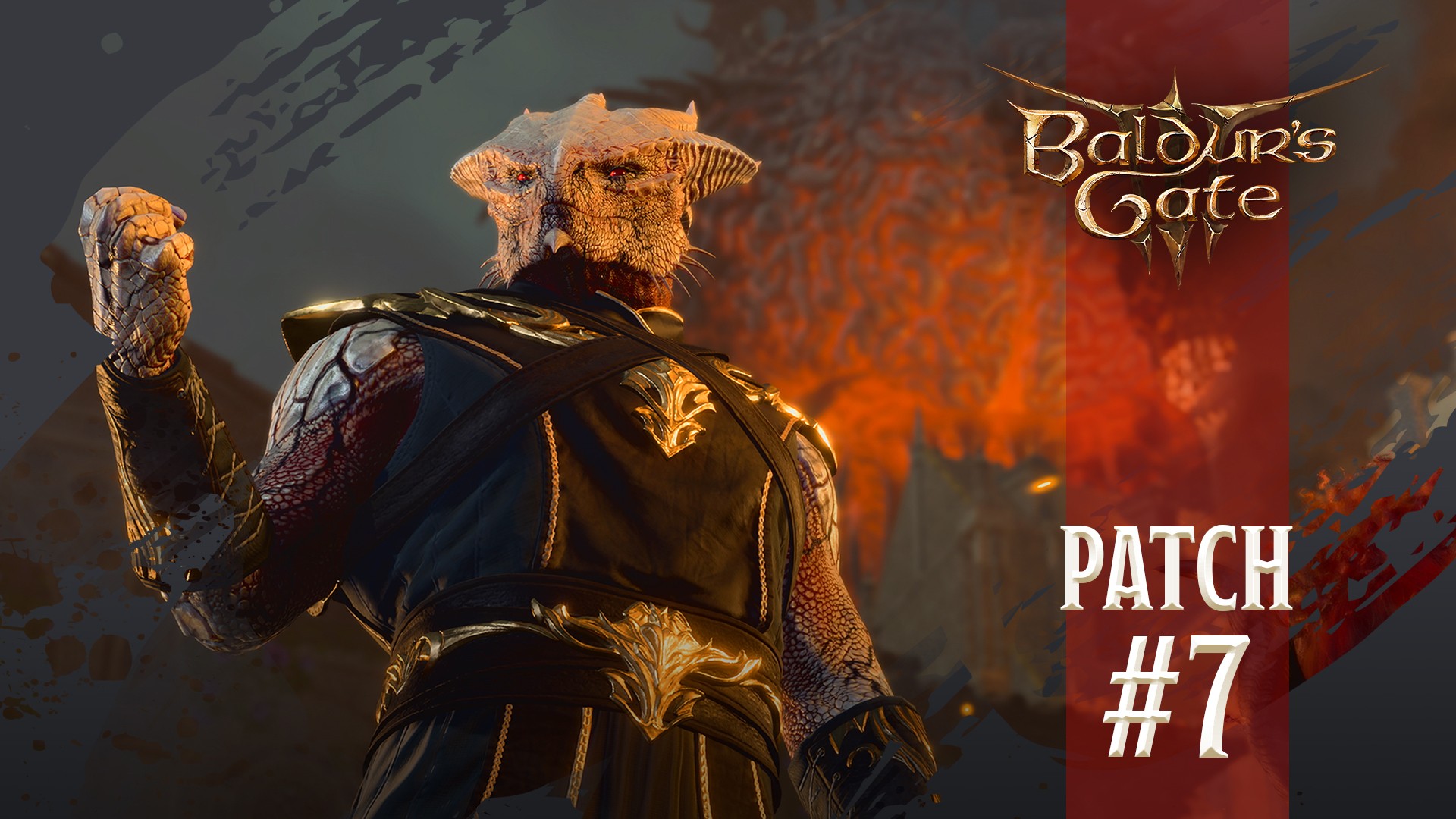
The release of Patch 7 for BG3 brought with it no significant combat, gameplay, or build-related change for the Solo Rogue Build. The main focus of this update was the final narrative additions, mostly centered around evil endings, along with official modding tools and adjustments to honor mode.
Furthermore, the game now features a modding toolkit and an in-game mod manager, allowing players to create and install mods directly within the game. Consequently, this update is intended to hand over creative control to the community. It enables players to produce unique content and continue the story in new ways.
Best Baldur’s Gate 3 Solo Rogue Build Summary
Armor: Light
Weapons: 2x Handcross Bows
Background: Urchin
- Strength – 8
- Dexterity – 17
- Constitution – 16
- Intelligence – 8
- Wisdom – 14
- Charisma – 10
Solo Rogue Level Progression
- Level 1 – Sneak Attack
- Level 2 – Cunning Actions
- Level 3 – Second Bonus Action
- Level 4 – Feat Sharpshooter
- Level 5 – Multiclass to Fighter
- Level 6 – Action Surge
- Level 7 – Battle Master Subclass
- Level 8 – Feat + Dexterity
- Level 9 – Extra Attack
- Level 10 – Multiclass to Ranger
- Level 11 – Spellcasting/Hunter’s Mark
- Level 12 – Gloom Stalker Subclass
Looking For More About Baldur’s Gate 3?
Thank you for reading the Best Baldur’s Gate 3 Solo Rogue Build Guide. We provide the latest news and create guides for Baldur’s Gate 3. Also, watch me play games on Twitch or visit my YouTube channel!
 Reddit
Reddit
 Email
Email

